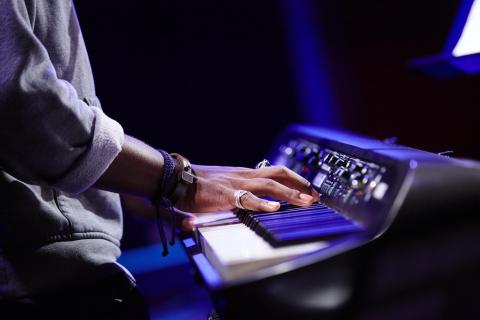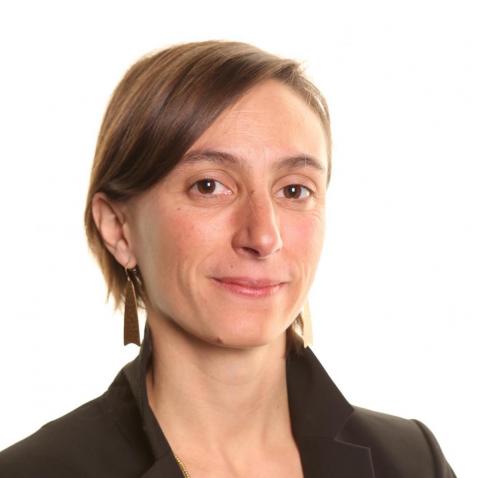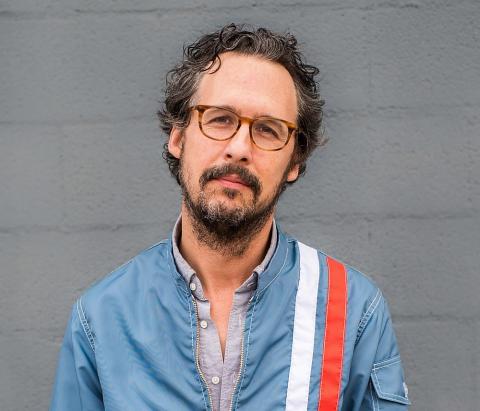Berklee Partners with MIT to Help Students Get Paid for Their Music

Image by Dave Green
Berkee has long advocated for the creation of a more open and transparent music business, one that gives artists more control over their music, their data, and ultimately their careers. When the college formed the Open Music Initiative (OMI) in 2016 with Netflix, YouTube, and dozens of other industry players, it set out to do just that.
OMI’s first priority: fixing the transfer of music metadata—the full information about an artist’s work, including the musicians, songwriters, producers, labels, and publishers involved in its creation—to ensure that when a song is played, the right people get paid and credited. The industry’s lack of standardized protocols for copyright attribution and royalty allocation have led to a tangled mess of licensing deals, rules, and intermediaries, resulting in error-filled royalty statements and millions in lost or misallocated royalties, leaving artists unpaid for their work.
The solution, according to OMI, was to develop an industry-wide framework linking artists and rights-holders to their works through a network of ledgers—an open-source model that has proven successful in the book publishing, auto parts, and library systems industries.
Berklee’s new licensing platform, RAIDAR, developed by OMI, is just such a framework, putting the initiative’s values and technical principles into practice. Built using blockchain technology, and designed in collaboration with MIT Connection Technology, RAIDAR allows Berklee students to license their music to visual-media students at other schools. RAIDAR is being piloted with the digital-filmmaking program at Lesley University, with plans to expand the platform not only to other film schools, but to other markets such as virtual reality and video games.
The platform uses smart contracts—agreements that self-execute when specific conditions are met—to eliminate the need for costly middlemen. And, unlike many music libraries, RAIDAR doesn’t act as a publisher or take a cut from its users; artists and rights-holders retain full control of their music, earning money from their songs wherever and whenever they are used.
Berklee students and alumni worked with MIT to design and code the project. Meghan Smyth M.M. ’19, a graduate of Berklee’s campus in Valencia, Spain, helped to integrate the platform with Berklee’s identity-validation system, and created the user-experience design for its educational materials. She first learned about OMI during Berklee’s Silicon Valley student trip, then started attending the tech calls with MIT that led to RAIDAR.
To learn more, we talked to RAIDAR cofounders George Howard, professor of music business at Berklee, and Nicole d’Avis, managing director of the Berklee Institute for Creative Entrepreneurship (BerkleeICE). Below are some excerpts from the interview.
What sets RAIDAR apart from other blockchain-based music platforms? What problems does it solve?
Howard: There are very few blockchain-based music platforms out there that are solving any problems in a meaningful way. RAIDAR was created by design to utilize the current state of the art of blockchain, rather than some aspirational one, to solve some very specific problems: (1) there is no decentralized, immutable ledger for Berklee students to ascribe their ownership to their works, which becomes extremely relevant in the case of disputes over creation and ownership; and (2) there is no current disintermediated licensing platform in which Berklee students (or anyone else, for that matter) can efficiently have their music licensed with the least amount of transaction costs possible (other services take anywhere from 15 to 99 percent of the licensing revenue). Blockchain tech—in its current state—solves for both: decentralized, permanent ledger and disintermediated transactions (via smart contracts).
Nicole d'Avis, managing director of Berklee’s Institute for Creative Entrepreneurship, is one of RAIDAR's cofounders.
Where did the idea come from?
Howard: It is a direct outgrowth of OMI, and is essentially the product that was birthed via the purpose of OMI; that is, an interoperable technological solution guided by OMI’s values in the service of helping artists to create sustainable careers on their own terms.
D’Avis: Open Music exists to promote interoperability, education, and innovation within the music industry, but how to do this can be quite abstract, especially when you get into the technological weeds. During our February 2019 member meeting in L.A., George; Thomas Hardjono, CTO of MIT Connection Science; and Eric Scace found a breakout room where they sketched out RAIDAR’s beginnings. This whiteboard sketch turned into a white paper, and then into something Berklee and MIT decided to build.
As Open Music convened industry members to discuss interoperability and open protocols, RAIDAR allowed us to show, rather than tell, what is possible with these abstract concepts. When we showcased an alpha version of RAIDAR at our November 2019 meeting, industry members saw that we could get to consensus and interoperability by building something. Members, partners, and artists started approaching us about wanting to connect to the project, and that’s when we knew we had something. Since then, we have accelerated development, despite the obvious challenges and delays of the pandemic. Thanks to an incredible team of developers, including Berklee Valencia alumna Meghan Smyth, we now have a working first version ready to roll out with students in the fall 2020 semester.
“We’ve built this largely from scratch, incorporating scalable solutions that will continue to make this platform as independent and artist-responsive as possible.”
—Nicole d’Avis, RAIDAR cofounder
How does the technology behind the platform work?
Howard: A Berklee student verifies—via a series of educational tutorials—that they have the unfettered right to license the musical work they’ve created. Once this is affirmed, the student uploads the work and, via a user-friendly user interface (UI), provides searchable metadata so that users of music—currently student filmmakers—can easily and quickly find music for their films. This is achieved through a UI that the film students have access to. Once found—via metadata searches, etc.—the film students purchase a nonexclusive license that gives them the right to use the music in their film, for a fee. Currently, it’s a set fee, but in future iterations the musicians will set the price.
George Howard, professor of music business and RAIDAR cofounder
D’Avis: On the front end, the user experience is quite simple. The platform starts with a few explainers of basic copyright concepts that all artists need to know. From there, students can upload their songs, adding metadata that identifies any contributors, including producers and engineers, and describes elements of the song, such as mood, genre, vocals versus instrumentals, and a field for free-text tagging. In the student’s profile, they can see and hear their uploaded songs, edit incorrect or missing metadata, and see what songs have been licensed, as well as the terms and payments related to those licenses.
The film student side is complementary, including the intellectual property education components. They can preview a downgraded version of the full audio and view the pricing and terms of the license before purchasing. Film students also have a profile where they can see and access all of their licensed music.
What users don’t see is that we’ve built this largely from scratch, incorporating scalable solutions that will continue to make this platform as independent and artist-responsive as possible, using emerging technologies like blockchain and IPFS [Interplanetary File System] that document ownership and transactions without that information being held by third-party for-profit services.
How are Berklee students contributing to this project? What new skills are they learning?
D’Avis: Through BerkleeICE’s Music + Blockchain course, students started finding out about RAIDAR, and wondered how they could get involved. So we opened up the weekly tech calls. As students saw needs—for example, initially needing a connection at a film school—they stepped in. We have students to thank for our first film school partner, Lesley University, because student Emily Chiang approached Matthew Nash, chair of Lesley’s digital filmmaking department. Once we needed to recruit Berklee students to upload their music, they stepped up, creating the intake form and designing the outreach campaign. Since going fully remote, participation has increased to the level where now the educational materials, marketing and communications, business development, and user experience are all being driven by students. As we wonder what the future of remote education should look like, this is it. There are no better ways for students to learn than by doing and teaching; RAIDAR is exactly this.
“We want to, in addition to adding more film schools, expand...into other poorly serviced verticals, such as VR, video games, health and wellness; all verticals where the licensing of music in 2020 is akin to booking travel in 1975.”
—George Howard, RAIDAR cofounder
How will you market the platform to find new users?
D’Avis: Students are leading the charge, telling everyone at Berklee and beyond about it. This fall, we will do student workshops across academic departments and join virtual events for prospective students considering Berklee. Students are also reaching out to film and other visual media university programs, sharing that their students can access a secure platform filled with high-quality, legally cleared music for their projects.
In the tech and innovation world, the project is referenced in an ebook on the new economy in development by Sandy Pentland, founder of MIT Connection Science, and Thomas Hardjono, so we have followers not only in the music industry but also from people interested in blockchain technology in general. While the blockchain world was full of hype a few years ago, many projects turned out to be vaporware [software or hardware that has been announced but gets stuck in development limbo]. The ecosystem has since contracted, leaving only projects that truly work—RAIDAR is one of those.
Howard: It will be deeply integrated across music business/management classes as a hands-on tool—built at Berklee—that shows how copyright, licensing, etc. actually works. Of course, once a few Berklee students start making money from this, they will tell their friends.
How do you plan to scale the platform? What new features will you add?
Howard: We want to, in addition to adding more film schools, expand the TAM [total addressable market] into other poorly serviced verticals, such as VR, video games, health and wellness; all verticals where the licensing of music in 2020 is akin to booking travel in 1975.
D’Avis: The platform will scale as the supply-demand relationship grows between Berklee students and visual-media students. We are very lucky to have an early adopter with Lesley University, who have been nimble and eager collaborators, weighing in with UI design, marketing, and education.
As with any first working version, we narrowed scope to the minimum viable features so that we could build as successful a platform as possible. That said, the developers included some very cool back-end features that will eventually become visible in future versions. We already have a growing wish list of features for this next generation of RAIDAR, including consumer-to-creator messaging; smart search and tagging informed by past entries on the consumer and creator side; a way for Berklee students to see popular search characteristics from the visual media students; a blockchain-based payment-distribution platform like Revelator; identity verification through an artist-centered platform such as Imogen Heap’s Creative Passport; and moving from storing songs on AWS [Amazon Web Services] to a distributed solution like IPFS.
How will you define success after the first year?
D’Avis: Success is students making money through their music, thus encouraging wider adoption; on the consumer side, increasing demand for Berklee music; and students feeling confident in their understanding of copyright and the value of their music.
Howard: It’s already a success—talk to the student team.

